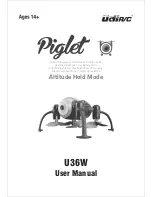
Follow these safety precautions when operating this drone.
Adult supervision required.
Do not turn on the drone unless controller has been turned on first.
Turn off controller and drone when not in use.
Do not touch the spinning blades or fly over another person’s head.
Do not submerge in water. This could damage electronic assemblies.
Keep your face and body as well as all spectators away from the rotors whenever the battery is connected.
Stay clear of buildings, trees, and power lines.
AVOID flying in or near crowded areas.
DO NOT fly close to people, children, or pets.
Maintain a safe pilot-to-drone distance while flying.
Your drone should not be considered a toy, but rather a small, working model. If not operated correctly, the
model could possibly cause injury to you or spectators and damage to property.
Do not alter or modify the model, as doing so may result in an unsafe or unflyable model.
You must check the operation of the model before every flight to insure that the model has remained structurally sound.
Do not operate in bad weather, including extremely high temperatures, heavy snow, high wind, or rain.
Do not fly in restricted air space.
CAUTION: Changes or modifications to this product not expressly approved by the party responsible for
compliance may void the user’s authority to operate the equipment.
To avoid fire, serious injury, and property damage, observe the following safety guidelines when using,
charging, or storing your batteries.
The drone is equipped with a rechargeable 3.7V LiPo battery. Please pay attention to the following cautions.
Parental guidance is recommended when installing batteries.
Do not attempt to use this charger with NiCd or NiMH battery packs.
Do not attempt to use a damaged battery.
Disconnect the battery from the charger and carefully move the battery to a fireproof location if the battery
begins to swell or smoke!
Do not attempt to charge a battery if it is swollen or hot.
Do not allow the batteries to come into contact with any kind of liquid.
Do not leave batteries out in the rain or near a source of moisture.
Do not drop the battery into water. If the inside of the battery comes into contact with water, chemical
decomposition may occur, potentially resulting in the battery catching on fire, and may even lead to an explosion.
Electrolytes in the battery are highly corrosive. If any electrolytes make contact with your skin or eyes, immediately
wash the affected area with fresh running water for at least 15 minutes, and then see a doctor immediately.
Land your model immediately when the LEDs flash to indicate that the battery power is low. Recharge the battery before
attempting another flight. A dangerous situation can occur when attempting to recharge an over-discharged battery!
If the battery falls into water with the aircraft during flight, take it out immediately and put it in a safe and
open area. Maintain a safe distance from the battery until it is completely dry. Never use the battery again, and
dispose of the battery properly as described in the Battery Disposal section below.
Do not put batteries in a microwave oven or in a pressurized container.
Do not place loose battery cells on any conductive surface, such as a metal table.
BATTERY INSTALLATION AND CHARGING
SAFETY PRECAUTIONS
BATTERY INSTALLATION AND CHARGING
BATTERY PRECAUTIONS
BATTERY INSTALLATION AND CHARGING
LiPo BATTERY USAGE


























